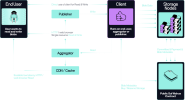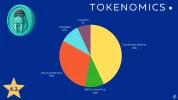- BHT
- 0
 5
5
 0
0
Binance Reaches Historic Milestone with 50th HODLer Airdrop Featuring Revolutionary Storage Protocol
Within just 72 hours of announcement, Binance 's 50th HODLer Airdrop featuring Walrus (WAL) attracted unprecedented attention from the cryptocurrency community, marking a significant milestone in the platform's reward distribution history. The program offers participants access to 32.5 million WAL tokens, representing one of the most substantial airdrop allocations in recent months.

The timing of this airdrop coincides with Walrus Protocol's successful $140 million private token sale and its mainnet launch on March 27, 2025, demonstrating strong institutional confidence in the project's innovative approach to decentralized storage solutions. For users holding BNB tokens in their Binance accounts, this presents an exceptional opportunity to gain exposure to a cutting-edge blockchain storage platform without additional investment.
Join the Walrus HODLer Airdrop Program Now
Understanding the Walrus Protocol: Revolutionizing Decentralized Storage
What Makes Walrus Different?
Walrus represents a paradigm shift in how blockchain networks handle data storage. Built on the Sui blockchain infrastructure, this decentralized storage protocol addresses critical challenges that have long plagued traditional storage solutions. The platform's innovative architecture combines cutting-edge encoding technology with blockchain's inherent security features to deliver unprecedented efficiency.
Unlike conventional storage platforms that rely on massive replication factors, Walrus introduces an intelligent approach to data management. The protocol's design philosophy centers on making large-scale data storage both economically viable and technically robust for Web3 applications, AI systems, and enterprise-grade solutions.
The Red Stuff Encoding Innovation
At the core of Walrus's technological advantage lies its proprietary Red Stuff encoding algorithm, a revolutionary two-dimensional erasure coding scheme that fundamentally transforms data storage efficiency. This groundbreaking technology fragments data into smaller segments called "slivers" that distribute across the network, creating a resilient storage ecosystem.
The engineering brilliance of Red Stuff becomes apparent when comparing replication factors. While established platforms like Filecoin require 100x replication and Arweave demands 500x replication to maintain data integrity, Walrus achieves comparable reliability with merely 4-5x replication. This dramatic reduction translates directly into lower storage costs, faster data retrieval times, and improved scalability without compromising security or availability.
The protocol generates 3f+1 sliver pairs for each data object, distributing these paired slivers across network nodes. Each pair consists of primary and secondary slivers, creating redundancy that ensures data remains accessible even if multiple nodes experience failures. This architectural decision provides robust fault tolerance while maintaining storage efficiency that surpasses industry standards.
Secure Your Position in the Walrus Airdrop
Programmable Storage on Sui Blockchain
Walrus leverages Sui blockchain's Move smart contract capabilities to transform static storage into dynamic, programmable resources. This integration enables developers to treat stored files as on-chain objects that can interact with decentralized applications seamlessly. The programmability aspect opens new possibilities for automated data management, conditional access controls, and intelligent storage solutions.
The protocol establishes proofs of availability upfront and confirms them through random challenge mechanisms, significantly reducing the computational cost associated with verifying file integrity. This approach ensures data remains retrievable while minimizing overhead, making Walrus particularly attractive for applications requiring frequent data access and verification.
Users can select storage durations extending up to two years, with flexible options to either delete or retain data after expiration. This flexibility, combined with cost-effective pricing structures, positions Walrus as an ideal solution for everything from temporary project files to long-term archival storage requirements.
Binance HODLer Airdrop Program: Comprehensive Overview
Program Structure and Token Distribution
The Walrus HODLer Airdrop represents Binance's 50th token distribution initiative, celebrating a milestone that underscores the exchange's commitment to rewarding its community. The program allocates 32.5 million WAL tokens exclusively to eligible BNB holders, providing participants with immediate exposure to one of 2025's most anticipated blockchain projects.

Binance's HODLer Airdrop mechanism operates on a historical snapshot system, automatically issuing new tokens based on participants' BNB holdings during specified periods. This approach rewards long-term holders while encouraging continued engagement with Binance's ecosystem. The distribution model ensures fair allocation proportional to each participant's contribution to the platform's liquidity and stability.
With WAL's total supply capped at 5 billion tokens and initial circulating supply representing 29.57% of this total, the airdrop allocation constitutes a meaningful portion of available tokens. This distribution strategy aims to establish broad community ownership while maintaining sufficient reserves for future development and ecosystem growth.
Eligibility Requirements Explained
Participation in the Walrus HODLer Airdrop requires meeting specific criteria designed to reward genuine platform users. Eligible participants must have subscribed BNB to either Simple Earn products (Flexible or Locked options) or On-Chain Yields offerings between October 1, 2025, at 00: 00 UTC and October 3, 2025, at 23: 59 UTC.
This 72-hour snapshot period captures users who demonstrated commitment to Binance's ecosystem before the airdrop announcement gained widespread attention. The requirement ensures distribution favors existing community members rather than opportunistic participants who might otherwise attempt to qualify solely for airdrop benefits.
Start Earning Walrus Tokens Today
Both Flexible and Locked Simple Earn subscriptions qualify equally for the airdrop, providing participants with options that match their liquidity preferences and risk tolerance. Flexible products allow immediate withdrawals, offering maximum liquidity, while Locked products typically provide higher yields in exchange for commitment to specific holding periods.
Calculating Your Airdrop Allocation
The distribution formula considers multiple factors to determine individual allocation amounts. Primary considerations include the total BNB amount subscribed to qualifying products, the duration of subscription during the snapshot period, and the proportional share relative to all eligible participants.
Users maintaining higher BNB balances throughout the entire snapshot window maximize their potential allocation. The calculation methodology weights continuous participation, rewarding consistency rather than last-minute deposits made solely to qualify for airdrop benefits.
Binance employs sophisticated algorithms that account for hourly snapshots, ensuring precise calculation of each user's average holdings during the qualification period. This granular approach prevents gaming the system through temporary large deposits timed specifically around snapshot moments.
Step-by-Step Guide to Participating in the Walrus Airdrop
Creating Your Binance Account
New users embarking on their Walrus airdrop journey must first establish a Binance account. The registration process begins by visiting the official Binance website and selecting the signup option. Users provide basic information including email address or phone number, create a secure password meeting platform requirements, and verify their contact method through confirmation codes.
Account security represents a critical consideration during setup. Enabling two-factor authentication immediately after registration adds essential protection against unauthorized access. Users should configure both SMS and authenticator app options when possible, creating multiple security layers that safeguard account assets.
Identity verification becomes necessary before accessing most Binance features, including Simple Earn products required for airdrop eligibility. The Know Your Customer process involves submitting government-issued identification documents and completing facial recognition verification. Processing typically completes within minutes, though complex cases may require additional review time.
Register and Qualify for Walrus Airdrop
Funding Your Account with BNB
After account activation, participants need to acquire BNB tokens for subscription to qualifying products. Multiple acquisition methods accommodate different user preferences and existing cryptocurrency holdings. Users already possessing cryptocurrency can deposit assets to Binance and convert them to BNB through the platform's trading interface.
For users starting fresh, direct BNB purchase options provide the most straightforward path. Binance supports numerous payment methods including credit cards, debit cards, bank transfers, and third-party payment processors. Each method carries different processing times and fee structures, allowing users to select approaches matching their priorities for speed versus cost efficiency.
The platform's peer-to-peer marketplace offers another acquisition avenue, connecting buyers directly with sellers in their regions. This option often provides competitive rates and supports various local payment methods not available through direct purchase channels.
Subscribing to Simple Earn Products
Navigating to Binance Earn from the main menu reveals the Simple Earn section containing Flexible and Locked product categories. Users select their preferred option based on liquidity needs and yield objectives, though both qualify equally for the Walrus airdrop regardless of potential return differences.
Flexible Simple Earn allows immediate redemption of subscribed assets at any time without penalties. This option suits users who prioritize liquidity while still wanting airdrop qualification. The subscription process requires selecting the BNB asset, entering the desired subscription amount, reviewing terms, and confirming the transaction.
Locked Simple Earn products commit BNB for predetermined periods ranging from seven days to several months. These typically offer higher yields than Flexible alternatives, compensating users for reduced liquidity. Participants should ensure their selected lock period extends through the airdrop snapshot window to maintain eligibility.
Monitoring Your Subscription Status
After successful subscription, users should verify their qualification status through the HODLer Airdrops page. This dedicated section displays upcoming and ongoing airdrop campaigns, participation status, estimated allocation amounts, and distribution schedules. Regularly checking this page ensures awareness of any issues requiring attention before snapshot completion.
The platform provides detailed transaction history showing subscription confirmations, timestamps, and asset quantities. Users can cross-reference this information with eligibility requirements to confirm all criteria are met. Any discrepancies should be addressed immediately through Binance customer support to avoid missing distribution opportunities.
Verify Your Airdrop Eligibility Now
Walrus Token Economics and Market Fundamentals
Supply Distribution and Tokenomics
Walrus implements a carefully structured tokenomics model designed to balance multiple stakeholder interests while supporting long-term protocol sustainability. The total supply cap of 5 billion WAL tokens establishes clear scarcity parameters that protect against unlimited inflation scenarios common in some blockchain projects.
The initial circulating supply represents approximately 1.48 billion tokens, constituting 29.57% of the maximum supply. This measured release strategy prevents immediate market oversaturation while ensuring sufficient liquidity for active trading and ecosystem development. The distribution includes allocations for community airdrops, team compensation, ecosystem development funds, and strategic reserve holdings.
The 32.5 million token HODLer Airdrop represents approximately 0.65% of total supply and 2.2% of initial circulating supply. This allocation provides meaningful distribution to Binance's community while preserving the majority of tokens for ongoing ecosystem expansion, developer incentives, and future growth initiatives.
Trading Pairs and Market Accessibility
Walrus officially launched trading on Binance on October 10, 2025, at 07: 30 UTC, with deposit functionality opening four and a half hours earlier at 03: 00 UTC. This staggered schedule allowed users to prepare for trading by ensuring adequate deposit confirmations before market opening.
The exchange supports multiple trading pairs including WAL/USDT, WAL/USDC, WAL/BNB, WAL/FDUSD, and WAL/TRY. This diverse pair selection accommodates various trading strategies and regional preferences, providing flexibility for both cryptocurrency-native users and those preferring stablecoin denominations.
WAL carries Binance's "seed tag" designation, indicating it represents a new project with potentially higher volatility characteristics compared to established assets. This classification helps users make informed decisions by clearly identifying tokens in earlier development stages that may experience significant price fluctuations.
Private Sale Success and Institutional Interest
The protocol's successful $140 million private token sale demonstrates substantial institutional confidence in Walrus's technology and market potential. This significant fundraising achievement occurred before public trading launch, indicating sophisticated investors completed extensive due diligence and concluded the project merited substantial capital allocation.
Private sale participation typically includes venture capital firms, strategic partners, and accredited investors who bring not only financial resources but also industry connections, technical expertise, and strategic guidance. These partnerships often provide crucial support during critical growth phases, helping projects navigate challenges and capitalize on opportunities.
The fundraising success positions Walrus with robust financial resources to support aggressive development timelines, attract top-tier talent, expand ecosystem partnerships, and sustain operations through various market conditions. This financial stability reduces risks associated with early-stage projects that might otherwise struggle with funding uncertainties.
Strategic Advantages of Participating in the Airdrop
Zero-Cost Token Acquisition Opportunity
The HODLer Airdrop presents a unique opportunity to acquire Walrus tokens without direct purchase, effectively providing zero-cost exposure to the project. Participants already holding BNB for various purposes can qualify without additional capital allocation, making this one of the most accessible entry points for token acquisition.

This cost-free acquisition model reduces investment risk significantly compared to purchasing tokens at market prices. Even if participants eventually decide Walrus doesn't align with their portfolio strategy, they incur no direct financial loss from receiving airdropped tokens. The worst-case scenario involves opportunity cost rather than actual capital loss.
For long-term BNB holders already utilizing Simple Earn products for passive yield generation, airdrop participation requires zero behavioral change. These users automatically qualify while continuing their existing strategies, essentially receiving bonus tokens for maintaining habits they would pursue regardless of airdrop availability.
Claim Your Free Walrus Tokens
Early Access to Innovative Technology
Airdrop participants gain immediate exposure to groundbreaking decentralized storage technology positioned to address critical infrastructure needs across Web3 ecosystems. Early adoption of innovative projects often correlates with significant appreciation potential, particularly when underlying technology solves genuine problems affecting industry growth.
Walrus's Red Stuff encoding represents genuine technological advancement rather than incremental improvement over existing solutions. The dramatic efficiency gains compared to established platforms suggest competitive advantages that could drive adoption across multiple use cases, from DeFi protocols requiring data availability to AI applications demanding large-scale storage capabilities.
The protocol's integration with Sui blockchain provides additional strategic positioning, connecting Walrus with one of the industry's fastest-growing ecosystems. Sui's focus on scalability, low transaction costs, and developer-friendly infrastructure attracts projects seeking alternatives to congested networks, potentially driving demand for Walrus storage services.
Portfolio Diversification Benefits
Adding Walrus to existing cryptocurrency portfolios introduces exposure to the decentralized storage sector, an infrastructure category that remains underrepresented in many investment strategies. This diversification reduces concentration risk by spreading capital across different blockchain use cases beyond pure financial applications.
Storage infrastructure projects often exhibit different market dynamics compared to DeFi protocols, layer-1 blockchains, or meme tokens. These projects derive value from utility and adoption metrics rather than purely speculative interest, potentially providing more stable performance characteristics during volatile market periods.
The airdrop allows portfolio diversification without requiring reallocation of existing holdings or new capital deployment. Participants maintain their current investment strategies while adding a completely new sector exposure, optimizing risk-adjusted returns through broadened market participation.
Technical Implementation and Security Considerations
Understanding Proof of Availability
Walrus employs sophisticated proof of availability mechanisms that ensure stored data remains accessible whenever users require retrieval. The protocol establishes these proofs upfront during the storage process, creating mathematical guarantees that data can be reconstructed from distributed slivers even if some nodes experience failures or become unavailable.
Random challenge systems verify continued data availability without requiring constant communication with every storage node. This approach dramatically reduces bandwidth requirements and computational overhead while maintaining high confidence in data integrity. Nodes must respond to periodic challenges by providing requested slivers, proving they continue storing assigned data segments.
The economic design incentivizes honest behavior through reward and penalty mechanisms. Nodes successfully responding to availability challenges earn protocol rewards, while failures result in slashed stakes. This game-theoretic approach aligns individual node incentives with overall network health, creating self-enforcing reliability.
Smart Contract Integration
Walrus's integration with Sui's Move smart contract language enables unprecedented programmability for stored data. Developers can create contracts that automatically manage storage lifecycles, implement conditional access controls, trigger actions based on storage events, and integrate storage seamlessly with decentralized application logic.
This programmability transforms storage from passive data repository into active protocol component capable of sophisticated interactions. Applications can automatically extend storage periods when certain conditions are met, grant temporary access to specific users based on smart contract logic, or trigger notifications when stored data requires attention.
The Move language provides enhanced safety guarantees compared to alternatives, reducing risks associated with smart contract vulnerabilities. This security focus proves particularly important for storage applications where data integrity and availability represent critical requirements that cannot tolerate compromise.
Network Resilience Architecture
The protocol's distributed sliver system creates remarkable resilience against node failures, network partitions, and targeted attacks. Because data reconstruction requires only a subset of total slivers rather than all distributed segments, the network maintains functionality even during significant disruptions affecting multiple nodes simultaneously.
Byzantine fault tolerance mechanisms protect against malicious actors attempting to corrupt or withhold data. The encoding scheme's mathematical properties ensure that even if some nodes provide incorrect information, the reconstruction algorithm can identify and exclude faulty data while successfully recovering the original content from honest nodes.
This resilience extends to geographic distribution strategies that spread slivers across diverse locations, jurisdictions, and infrastructure providers. Such distribution mitigates risks from regional internet outages, natural disasters, or regulatory actions that might impact nodes in specific areas without affecting global network availability.
Walrus Ecosystem and Future Development Roadmap
Current Adoption and Use Cases
The protocol has already attracted attention from diverse application categories recognizing the value of efficient, decentralized storage. DeFi platforms utilize Walrus for storing transaction history, user interface assets, and audit trails that require permanent availability but generate prohibitive costs on traditional blockchain storage.
Non-fungible token projects leverage the platform for metadata storage, ensuring artwork descriptions, attributes, and external resource links remain accessible long-term without depending on centralized servers. This application addresses a critical NFT industry concern where valuable digital assets risk losing associated metadata if centralized storage providers discontinue services.
Artificial intelligence applications represent another growing use case, as machine learning models and training datasets require substantial storage capacity. Walrus's cost efficiency makes decentralized AI storage economically viable, supporting the growing intersection between blockchain technology and artificial intelligence innovation.
Join the Growing Walrus Ecosystem
Developer Tools and Integration Support
Walrus provides comprehensive developer tools that simplify integration processes for application builders. Software development kits support multiple programming languages, enabling developers to incorporate storage functionality without extensive blockchain expertise. These tools abstract complex technical details while exposing powerful capabilities through intuitive interfaces.
Documentation resources include detailed tutorials, code examples, and best practice guides that accelerate development cycles. The project maintains active developer communities where builders share knowledge, troubleshoot challenges, and collaborate on innovative applications utilizing Walrus infrastructure.
Testnet environments allow risk-free experimentation where developers can prototype applications, test integration patterns, and validate functionality before committing to mainnet deployment. These sandbox environments mirror production capabilities while eliminating financial costs associated with development mistakes or iterative refinement.
Partnership Ecosystem and Strategic Collaborations
Strategic partnerships with leading blockchain projects expand Walrus's utility and adoption potential. Integrations with established protocols create immediate use cases while demonstrating the technology's practical applicability across diverse scenarios. These collaborations often result in co-marketing initiatives that raise awareness among broader audiences.
Infrastructure partnerships with data centers, cloud providers, and internet service providers strengthen the physical network supporting Walrus nodes. These relationships ensure geographic diversity, reliable connectivity, and professional-grade hardware that enhance overall network performance and reliability.
Academic collaborations advance the theoretical foundations underlying Walrus technology, contributing to research publications, algorithm improvements, and next-generation innovations. These partnerships connect the project with cutting-edge academic research while training the next generation of distributed systems engineers.
Risk Management and Investment Considerations
Understanding Market Volatility
New token listings typically experience heightened volatility as markets establish fair value through price discovery processes. Walrus encountered significant trading activity following its Binance debut, with prices fluctuating as participants responded to supply dynamics, technical analysis patterns, and evolving market sentiment.

The seed tag designation explicitly warns users about elevated risk characteristics associated with newer projects. These tokens often experience larger percentage price movements compared to established assets, creating both opportunity and risk depending on entry timing and market conditions during holding periods.
Long-term success depends on multiple factors beyond initial hype cycles, including continued technical development, growing ecosystem adoption, competitive positioning against emerging alternatives, and broader market conditions affecting cryptocurrency valuations generally. Patient investors focusing on fundamental project strength often fare better than those chasing short-term price momentum.
Regulatory and Compliance Landscape
Cryptocurrency regulations continue evolving globally, with jurisdictions implementing diverse approaches ranging from supportive frameworks to restrictive limitations. Projects operating internationally must navigate complex legal environments that may impact token accessibility, trading availability, or operational requirements in specific regions.
Walrus's utility-focused design may provide regulatory advantages compared to purely speculative tokens. Storage services deliver tangible value supporting legitimate use cases, potentially positioning the project favorably as regulators develop nuanced frameworks distinguishing between different cryptocurrency categories.
Participants should understand applicable regulations in their jurisdictions, including tax obligations related to airdrop receipts, trading activities, and token holdings. Professional tax advice proves valuable for managing compliance responsibilities while optimizing after-tax returns through strategic planning.
Portfolio Allocation Strategies
Financial advisors typically recommend limiting cryptocurrency exposure to percentages aligned with individual risk tolerance levels, often suggesting 5-10% of total investment portfolios for most retail investors. Within cryptocurrency allocations, further diversification across multiple projects and use cases helps manage project-specific risks.
Airdrop participation provides exposure without requiring traditional portfolio rebalancing that might otherwise necessitate selling existing holdings. This characteristic allows maintaining target allocations while opportunistically adding new positions that enhance diversification without disrupting established investment strategies.
Regular portfolio reviews help ensure allocations remain aligned with investment objectives as market conditions evolve and individual circumstances change. Rebalancing strategies that trim outperforming positions and add to underperformers help maintain target exposures while systematically capturing gains from successful investments.
Maximizing Value from Your Airdrop Allocation
Token Custody and Security Best Practices
After receiving airdrop tokens, participants face important decisions regarding custody arrangements. Leaving tokens on Binance provides convenience for active trading but exposes holdings to exchange security risks. Platform breaches, though increasingly rare at major exchanges, represent potential threats to assets maintained in exchange wallets.
Self-custody through personal wallets grants complete control over tokens while transferring security responsibility to individual users. Hardware wallets provide maximum security for long-term storage by keeping private keys offline and isolated from internet-connected devices vulnerable to hacking attempts.
Multi-signature wallet configurations enhance security for larger holdings by requiring multiple approvals before authorizing transactions. This approach protects against single points of failure, whether technical vulnerabilities, physical theft, or personal coercion scenarios targeting cryptocurrency owners.
Strategic Holding vs. Trading Decisions
Participants must determine whether to maintain airdrop allocations long-term or liquidate positions for immediate profit-taking. Long-term holding strategies bet on continued project development, growing adoption, and eventual value appreciation as Walrus matures and captures market share within decentralized storage sectors.
Active trading approaches attempt to capitalize on short-term price volatility by buying during temporary dips and selling during rallies. This strategy requires significant time commitment, technical analysis skills, and emotional discipline to avoid common pitfalls like revenge trading or FOMO-driven decisions during extreme market movements.
Hybrid approaches combine elements of both strategies, maintaining core long-term positions while trading portions of holdings to generate income and reduce average cost basis through strategic buying and selling. This balanced methodology allows participating in upside potential while taking some profits during favorable conditions.
Yield Generation Opportunities
Beyond simple holding, Walrus tokens may present additional yield generation opportunities through various DeFi protocols and exchange products. Lending platforms might offer interest on WAL deposits, allowing passive income generation while maintaining exposure to potential price appreciation.
Liquidity provision in decentralized exchange pools enables earning trading fees by supplying both Walrus tokens and paired assets to automated market makers. This strategy generates ongoing returns proportional to trading volume but introduces impermanent loss risks that require understanding before commitment.
Staking opportunities, if implemented by the Walrus protocol, could provide native yield through network participation rewards. These programs typically lock tokens for specific periods in exchange for protocol emissions, creating additional incentive layers beyond basic token price appreciation.
Community Engagement and Educational Resources
Official Communication Channels
Staying informed about Walrus developments requires following official communication channels that provide verified information directly from the project team. The main website serves as the primary resource hub containing technical documentation, blog posts announcing updates, and links to other official properties.
Social media accounts on Twitter, Telegram, and Discord facilitate real-time communication between team members and community participants. These channels host announcements, answer questions, share ecosystem developments, and provide forums for community members to connect and collaborate on Walrus-related initiatives.
Email newsletters deliver curated updates directly to subscribers, ensuring important announcements reach engaged community members regardless of social media algorithm changes or platform issues. Newsletter subscriptions typically offer the most reliable delivery method for critical updates requiring broad distribution.
Educational Content and Learning Resources
Understanding Walrus technology requires accessing quality educational materials that explain complex concepts accessibly. The project maintains extensive documentation covering technical architecture, integration guides, API references, and conceptual overviews suitable for various knowledge levels from beginners to experienced developers.
Third-party content creators produce supplementary educational materials including tutorial videos, written guides, podcast discussions, and analytical deep dives. These resources often present information from fresh perspectives and use cases that complement official documentation with practical applications and real-world examples.
Community-created content showcases innovative implementations, shares best practices, and documents lessons learned from actual usage. These grassroots resources prove invaluable for understanding practical considerations that may not appear in official documentation focused primarily on technical specifications.
Participating in Governance and Protocol Evolution
As the Walrus ecosystem matures, governance mechanisms may grant token holders influence over protocol decisions through proposal and voting systems. Active participation in governance processes allows community members to shape project direction, prioritize development initiatives, and influence resource allocation decisions.
Understanding governance proposals requires evaluating technical implications, economic impacts, and strategic considerations affecting long-term project success.informed voting demands researching proposal details, considering community discussions, and assessing alignment between suggested changes and personal interests as token holders.
Constructive community participation extends beyond voting to include proposal creation, technical feedback, bug reporting, and ecosystem building activities. These contributions strengthen the overall project while establishing contributors as valuable community members who may benefit from recognition, opportunities, or rewards as the ecosystem develops.
Comparing Walrus to Alternative Storage Solutions
Traditional Decentralized Storage Competitors
Filecoin pioneered decentralized storage markets by creating economic incentives for individuals to contribute unused storage capacity. While successfully establishing a large network, Filecoin's high replication requirements generate costs that limit adoption for price-sensitive use cases requiring large storage volumes.
Arweave offers permanent storage solutions through its "pay once, store forever" model that appeals to use cases requiring guaranteed long-term availability. However, the even higher replication factors compared to Filecoin create premium pricing that restricts economically viable applications to high-value data justifying substantial upfront costs.
Storj and Sia provide decentralized alternatives emphasizing privacy and encryption, fragmenting files across distributed nodes. These projects serve niches prioritizing confidentiality over pure cost efficiency, attracting users with sensitive data requiring enhanced security guarantees beyond typical storage requirements.
Walrus's Competitive Positioning
Walrus differentiates through its Red Stuff encoding efficiency that dramatically reduces storage overhead while maintaining comparable reliability guarantees. This technological advantage translates into cost structures that potentially undercut competitors significantly, expanding the range of economically viable use cases for decentralized storage.
Integration with Sui blockchain provides performance characteristics that complement storage functionality, enabling applications requiring both fast transaction processing and efficient data availability. This unified infrastructure simplifies development compared to architecting solutions that bridge separate storage and computation layers.
The programmable storage paradigm opens possibilities unavailable in traditional storage solutions where data remains static and separate from application logic. This innovation positions Walrus for emerging use cases that haven't fully developed yet but will benefit from storage-computation convergence as Web3 applications grow more sophisticated.
Conclusion: Walrus Represents the Future of Decentralized Storage
The Walrus Protocol stands at the intersection of multiple powerful trends reshaping blockchain infrastructure, from the explosive growth of AI applications requiring massive data storage to the maturation of Web3 ecosystems demanding reliable, cost-effective infrastructure supporting sophisticated applications.
The Binance HODLer Airdrop provides exceptional access to this innovative project without capital requirements or complex qualification processes. Eligible participants receive meaningful token allocations that offer exposure to cutting-edge technology addressing genuine industry needs with novel solutions demonstrating measurable advantages over established alternatives.
For those already utilizing Binance Simple Earn products, participation represents a straightforward opportunity to diversify portfolios and explore emerging infrastructure categories. New users can quickly establish positions by following the detailed guidance provided throughout this comprehensive resource, ensuring they don't miss this limited-time distribution opportunity.
The storage infrastructure sector remains relatively nascent within broader blockchain ecosystems, suggesting significant growth potential as adoption increases across DeFi, NFTs, AI applications, and countless emerging use cases not yet imagined. Early participants who recognize fundamental value before widespread awareness may benefit substantially as the market matures and infrastructure importance becomes increasingly apparent.
Secure Your Walrus Tokens Before the Airdrop Ends
Whether approaching Walrus as a long-term infrastructure investment, short-term trading opportunity, or simply an interesting technological development worth minimal exposure, the HODLer Airdrop provides accessible entry point requiring no direct capital outlay. This risk-reward profile makes participation compelling for virtually anyone interested in blockchain technology evolution and cryptocurrency market opportunities.
The combination of proven technology through successful mainnet launch, substantial institutional backing via $140 million in private funding, strategic exchange partnerships with Binance listing, and growing ecosystem adoption positions Walrus favorably for continued development and potential value appreciation as the project executes its ambitious roadmap and expands its user base across diverse application categories.







